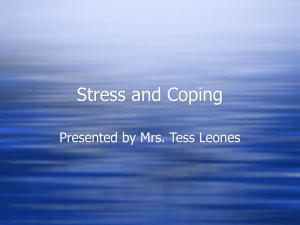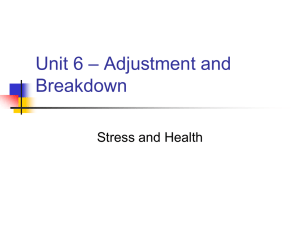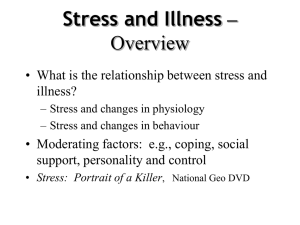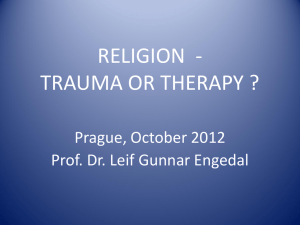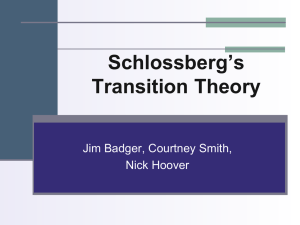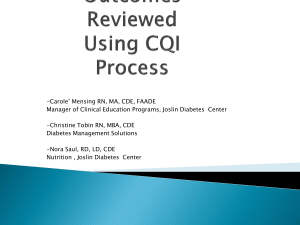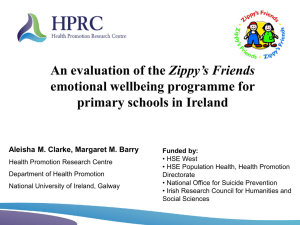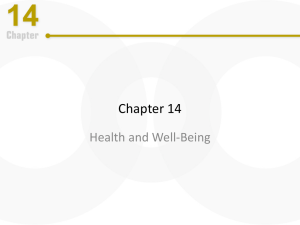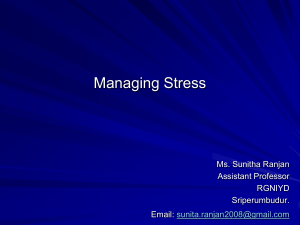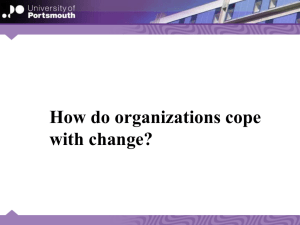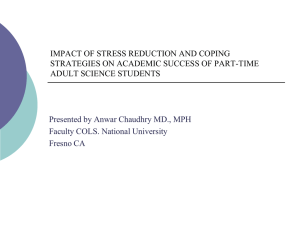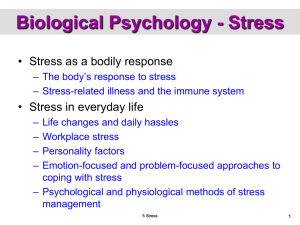Stress
advertisement
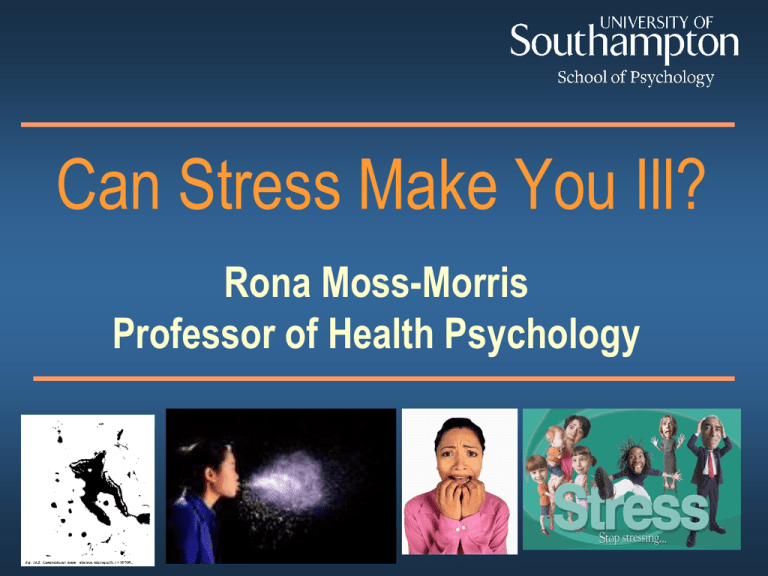
Can Stress Make You Ill? Rona Moss-Morris Professor of Health Psychology DIVISION OF HEALTH PSYCHOLOGY www.bps.org.uk/dhp Email: dhp@bps.org.uk Lecture outline The Biopsychosocial Model of health and illness What is stress and how do we measure it? The Pittsburgh Common Cold Studies Buffers between stress and illness - Stress and coping model - Social support The Biomedical Model The Biopsychosocial Model Illness Stressors Any circumstances that threaten or are perceived to threaten one’s well-being and thereby tax one’s coping ability An upcoming exam Attending a party where you don’t know anyone Being diagnosed with a serious illness Break up of a relationship Stress Our physiological & psychological responses to conditions that threaten or challenge us in some way Psychological responses include: –Emotions e.g. anxiety –Thoughts e.g. ‘No-one will talk to me’ –Behaviours e.g. ‘ drinking too much’ Fight-or-Flight (Walter Canon, 1932) “aggressive or withdrawal responses to stress” Stress response controlled by the brain Physiological Stress Response Stimulates muscles Stress and measurement Environmental Psychological Biological Measuring Stress Social Readjustment Rating Scale Events causing the greatest life changes considered most stressful – – – – Death of a spouse Divorce Marriage Fired from work Holmes and Rahe, 1967 SRSS Scores & Health (Rahe, et.al, 1964) The Daily Hassles Scale Measures irritating, daily demands as rated by the person – concerns about weight too many things to do misplacing things – argument with family member, – – Stronger associations with illness better than the SRRS Kanner et al. (1981) Cohen’s Perceived Stress Scale (PSS) 10 item questionnaire rated over past month - how often have you felt nervous or stressed - how often have you felt on top of things - how often have you been upset because of something that happened unexpectedly - how often have you felt difficulties were piling up so high that you could not overcome them The Common Cold Studies (Cohen et al 1991; 1993) Large scale prospective experimental investigations of stress and the common cold •PSS •Life events •Mood Exposed to cold virus •Replicated virus •Clinical symptoms Age, gender, weight, ethnicity, season, smoking, alcohol, diet exercise, sleep not related to stress and illness How many people developed colds? Viral Infection 82% of the volunteers receiving virus were infected. Clinical Colds Clinical Colds = both infected and diagnosed by the clinician as having a clinical cold. 38% developed clinical colds. Which stress factors predicted colds? Perceived Stress (PSS) Life events Negative mood PSS & negative mood predicted actual viral infection Life events predicted development of clinical symptoms Associations between each of the stress measures and rates of clinical colds Does the type of stressor matter? Cohen et al. (1998) Health psychology, 17, 214-223 Life Events and Difficulties Schedule (LEDS; Brown & Harris, 1989) Detailed interview schedule Rates events in the last year as - severe acute events severe chronic difficulty (stressor) Relative risk of developing a cold by stressor duration Does the type of stressor matter? Conclusions: Longer, more chronic stress – more infection Interpersonal and work stress – more infections Explaining the relationship between stress and illness Direct effects hypothesis stress impacts on our hormones and immune systems Indirect effects hypothesis stress impacts on health through changes in health behaviour e.g. diet, exercise, smoking, drinking Mediators or Mechanisms Hormones? Immune system? Behaviours? Stress Common cold Behaviour as a Mechanisms Health behaviours Stress Common cold Hormones as Mechanisms Neuroendocrine hormones e.g. adrenal, cortisol Stress Common cold Immune System as a Mechanisms Increase in IL-6 Cytokines Stress Common cold Explaining the Cytokine pathways Acute stress related to more cortisol which can suppress immune responsiveness Chronic ongoing stress related to decreased cortisol Less cortisol may lead to inability to switch off immune responsiveness Body produces more IL-6 – therefore more symptoms. Stress and Stroke-Study 2,303 Finnish middle-aged white men followed for 11 years Measured blood pressure spikes (in anticipation of an exercise test) Men with above average blood pressure spikes had a 72% greater risk of developing a stroke in the following 11 years Susan A. Everson et al., 2001 Moderators of Stress Appraisal and Coping Social Support Stress and Coping Model (Folkman & Lazerus, 1984) Secondary Appraisal: What resources do I have to cope with this threat? Coping Strategy Emotion Focused Coping Coping through emotional approach involves actively processing and expressing emotion (Stanton et al. 2000). The emotional approach scale – – emotional processing - “I take time to figure out what I’m really feeling” emotional expression ( “I let my feelings come out freely”) Emotional Processing and Cancer Study of women with stage I or II breast cancer over 3 months (Stanton et al. 2000) coping through emotional expression associated with improved – – – decreased distress, fewer medical visits increased vigour at 3 months Coping through emotional processing associated with increases in distress Emotional processing appears to be adaptive in the short term Over the longer term may become ruminative and therefore less beneficial in terms of adjustment. Coping Effectiveness The contextual approach - no strategy is inherently bad Short term and long term effects Some strategies like avoidance, denial and emotional processing may work well in short term but not in long term Controllable stressors better linked to problem focused coping and uncontrollable to emotion focused coping. Appraisals of coping efficacy What is social support (SS)? Social network Perceived social support (amount available) Received social support Pathways from SS to health/illness Cardiovascular (heart) system individuals with high SS at work have lower mean heart rate than those with low SS (Unden et al., 1991) Immune system individuals with more social ties less susceptible to common cold (Cohen et al., 1997); immunoglobin A (first line of defence) higher in college students with high SS (Baron et al., 1990) Neuroendocrine system (hormones) presence of supportive companion during stress test lower cortisol response (Kirschbaum et al., 1995) Summary and Conclusions Stress is linked to increased illness particularly chronic stress This seems to occur through direct effects on immune responsiveness (overactive rather than underactive) Stress can be buffered through the way people perceive situations, their coping style and social support These buffers can be used in interventions to reduce impact of stress. DIVISION OF HEALTH PSYCHOLOGY www.bps.org.uk/dhp Email: dhp@bps.org.uk

